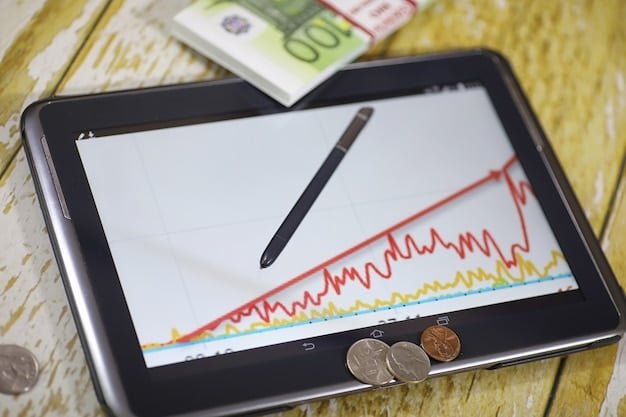The Impact of BNPL on Credit Card Use in the US

The impact of Buy Now, Pay Later (BNPL) services on traditional credit card usage in the US is significant, particularly among younger consumers, influencing spending habits and potentially leading to decreased reliance on conventional credit cards.
The rise of Buy Now, Pay Later (BNPL) services has undeniably altered the financial landscape, especially concerning how Americans manage their purchases. The impact of Buy Now, Pay Later (BNPL) services on traditional credit card usage in the US is now a key topic for consumers and financial institutions alike.
Understanding the Popularity of Buy Now, Pay Later
Buy Now, Pay Later (BNPL) services have surged in popularity in recent years, offering an alternative to traditional credit cards. This rise is particularly notable among younger consumers who are drawn to the perceived simplicity and accessibility of BNPL options.
BNPL services allow consumers to make purchases and pay them off in installments, often without interest if payments are made on time. This model is attractive to those who may not qualify for credit cards or prefer to avoid high-interest rates and revolving debt.
Factors Driving BNPL Adoption
- Accessibility: BNPL services often have less stringent credit requirements compared to traditional credit cards, making them accessible to a broader range of consumers.
- Simplicity: The straightforward payment structure and transparent terms appeal to consumers looking to avoid complex credit card agreements.
- Interest-Free Options: Many BNPL providers offer interest-free payment plans, attracting those wary of accumulating interest charges on their purchases.
- Integration at Point of Sale: BNPL options are frequently integrated directly into online checkout processes, making them a convenient and seamless payment choice.
The shift towards BNPL reflects changing consumer preferences and a growing desire for flexible and transparent payment solutions.

The Shift in Consumer Spending Habits
The increasing adoption of BNPL services is influencing how consumers manage their spending. With the availability of installment payment options, individuals may be more inclined to make purchases they might otherwise delay or forgo.
This shift can have both positive and negative impacts on personal finances. On one hand, it can enable consumers to acquire necessary goods and services without immediately incurring debt. On the other hand, it may lead to overspending and difficulty managing multiple payment plans.
The Impact on Credit Card Spending
As BNPL gains traction, there is evidence of a potential decrease in traditional credit card usage in certain segments. Some consumers are opting to use BNPL services for smaller purchases, reserving their credit cards for larger transactions or emergencies.
However, credit cards still offer benefits such as rewards programs and credit-building opportunities that BNPL services may not provide. It’s essential for consumers to weigh the advantages and disadvantages of each payment method when making purchasing decisions.
BNPL is certainly influencing the way consumers approach budgeting, planning, and making purchases.

Comparing BNPL and Credit Cards: A Detailed Analysis
When evaluating the impact of BNPL on credit card usage, it’s crucial to understand the differences between these two payment methods. Both offer ways to finance purchases, but they operate on distinct principles.
Credit cards are revolving credit lines, allowing users to borrow funds and repay them over time, subject to interest charges if balances are not paid in full. BNPL services, on the other hand, typically offer fixed-term installment plans, often without interest if payments are made on schedule.
Key Differences Between BNPL and Credit Cards
Understanding the differences helps consumers to make informed decisions on which payment method best suits their needs and financial situation.
- Credit Checks: Credit cards generally require a thorough credit check, while BNPL services may have more lenient approval processes.
- Interest Rates: Credit cards charge interest on outstanding balances, while BNPL services often offer interest-free payment plans.
- Credit Limits: Credit cards come with pre-set credit limits, while BNPL services provide financing on a per-purchase basis.
- Rewards Programs: Many credit cards offer rewards programs, such as cashback or travel points, which are typically not available with BNPL services.
The choice between BNPL and credit cards depends largely on individual preferences, financial goals, and spending habits.
Potential Risks and Challenges of BNPL
While BNPL offers convenience and flexibility, it’s essential to be aware of the potential risks and challenges associated with these services. Overspending and accumulating multiple payment plans can lead to financial strain if not managed responsibly.
Late fees and penalties for missed payments can quickly add up and negate the benefits of interest-free financing. Additionally, BNPL services may not provide the same level of consumer protection as credit cards in cases of fraud or disputes.
Financial Implications of BNPL
The ease of accessing BNPL options can sometimes mask the true cost of purchases, leading to impulsive spending and increased debt. It’s crucial for consumers to carefully review the terms and conditions of BNPL agreements and budget responsibly.
- Overspending: The availability of installment payments can encourage consumers to make purchases they can’t truly afford.
- Late Fees: Missed payments can trigger late fees, which can significantly increase the overall cost of the purchase.
- Debt Accumulation: Managing multiple BNPL plans can be challenging and may lead to over-indebtedness.
- Impact on Credit Score: While some BNPL providers report payment activity to credit bureaus, others do not, potentially limiting credit-building opportunities.
Awareness of these risks is essential for making informed decisions about using BNPL services.
The Future of Credit Cards in the Age of BNPL
The rise of BNPL has prompted credit card companies to adapt their offerings and strategies to remain competitive. Some issuers are introducing installment payment options for credit card purchases, while others are focusing on enhancing rewards programs and customer service.
The future of credit cards may involve a greater emphasis on flexibility and personalization, with tailored benefits and payment options designed to meet individual consumer needs. It’s also possible that credit card companies will collaborate with BNPL providers to offer integrated payment solutions.
Adapting to Changing Consumer Preferences
As consumer preferences evolve, credit card companies are recognizing the need to innovate and offer value propositions that resonate with younger generations. This may involve streamlining application processes, enhancing digital experiences, and promoting financial literacy.
Also, card issuers are reevaluating their pricing models to ensure fairness and transparency.
The ongoing competition between BNPL and credit cards is likely to drive innovation and ultimately benefit consumers by providing more choices and better financial solutions.
Strategies for Consumers: Balancing BNPL and Credit Cards
For consumers, the key to successfully navigating the evolving payment landscape lies in understanding the strengths and weaknesses of both BNPL and credit cards. By adopting a balanced approach, individuals can leverage these tools to achieve their financial goals.
Using BNPL for smaller, manageable purchases and reserving credit cards for larger transactions or emergencies can be a prudent strategy. It’s also essential to track spending, manage payment schedules, and avoid accumulating excessive debt.
Tips for Responsible Financial Management
- Budgeting: Create a budget that accounts for all income and expenses, including BNPL payments and credit card balances.
- Payment Tracking: Use a budgeting app or spreadsheet to monitor BNPL payment schedules and credit card due dates.
- Credit Score Monitoring: Regularly check your credit score to ensure that BNPL and credit card usage is not negatively impacting your creditworthiness.
- Financial Education: Take advantage of financial literacy resources to learn more about responsible borrowing and debt management.
With careful planning and disciplined financial habits, consumers can harness the benefits of both BNPL and credit cards while minimizing the risks.
| Key Point | Brief Description |
|---|---|
| 🚀 BNPL Growth | Rapid adoption, especially among younger consumers. |
| 💳 Credit Card Impact | Possible decrease in usage for smaller purchases. |
| ⚠️ BNPL Risks | Potential for overspending and debt accumulation. |
| 💡 Consumer Strategy | Balance BNPL and credit cards for responsible spending. |
Frequently Asked Questions
▼
▼
▼
▼
▼
Conclusion
In conclusion, the rise of Buy Now, Pay Later (BNPL) represents a significant shift in consumer finance, impacting traditional credit card usage in the US; while BNPL offers convenience and accessibility, especially to younger consumers, it also presents potential risks such as overspending and debt accumulation, thus requiring consumers to balance the usage of BNPL and credit cards responsibly to maintain financial well-being.





